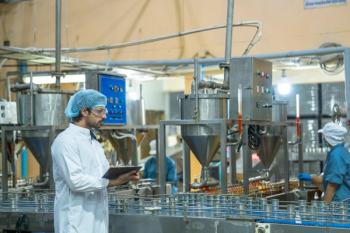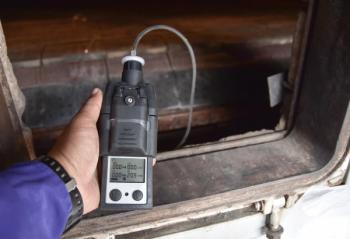
High-Throughput Isotopic Analysis of Uranium Particles for Nuclear Safeguards Using Single-Particle ICP-TOF-MS
Key Takeaways
- SP-ICP-TOF-MS offers rapid, high-throughput uranium isotope ratio analysis, distinguishing between natural, depleted, and low-enriched uranium.
- Environmental sampling by the IAEA involves cotton swipes analyzed through particle or bulk analysis for nuclear safeguards.
Spectroscopy spoke to Benjamin Manard, Senior R&D Staff Scientist and the Group Leader of the Chemical & Isotopic Mass Spectrometry Group at Oak Ridge National Laboratory (ORNL) as well as to Sarah Szakas and Jordan Stanberry, postdoctoral researchers at ORNL, regarding their work using examined single-particle inductively coupled plasma time-of-flight mass spectrometry (SP-ICP-TOF-MS) as a novel technique for uranium particle isotope ratio measurements.
Since the 1970s, the International Atomic Energy Agency (IAEA) has relied on environmental sampling to verify nuclear materials, traditionally using bulk digestion and particle-level mass spectrometry methods such as thermal ionization mass spectrometry (TIMS), inductively coupled plasma mass spectrometry (ICP-MS), large geometry secondary ion mass spectrometry (LG-SIMS).While these approaches provide high precision, they can suffer from long turnaround times, limited throughput, or loss of individual particle information. Laser ablation ICP-MS has demonstrated improved efficiency, but new methods are still needed.
A recent study published in Talanta examined single-particle inductively coupled plasma time-of-flight mass spectrometry (SP-ICP-TOF-MS) as a novel technique for uranium particle isotope ratio measurements. SP-ICP-TOF-MS allows simultaneous multi-element detection across thousands of particles within minutes, with relative standard deviations as low as 2%. Results demonstrate its capability to distinguish natural, depleted, and low-enriched uranium, highlighting its potential as a high-throughput tool for IAEA nuclear safeguards and forensic applications. LCGC International spoke to Benjamin Manard, Senior R&D Staff Scientist and the Group Leader of the Chemical & Isotopic Mass Spectrometry Group at Oak Ridge National Laboratory (ORNL) as well as to Sarah Szakas and Jordan Stanberry, postdoctoral researchers at ORNL, three of the authors of the paper (1) that resulted from this study.
How has the role of the IAEA evolved since the implementation of the Treaty on the Non-Proliferation of Nuclear Weapons (NPT) in 1970, particularly with the adoption of environmental sampling techniques?
When the NPT was initially adopted, the IAEA’s nonproliferation efforts focused on verifying declared nuclear materials and activities. Essentially, the IAEA was focused on ensuring that declared materials were accounted for and had not been diverted (2). In 1996, the IAEA officially implemented their environmental sampling (ES) program in which inspectors use cotton swipes to sample various surfaces in nuclear facilities to check for undeclared nuclear materials and activities (2).
Can you walk us through the process of collecting and preparing environmental swipe samples for nuclear safeguards analysis?
Most commonly, inspectors from the IAEA use cotton swipes (10 × 10 cm) to collect particulate matter from surfaces in nuclear facilities around the world. The swipes are then shipped to the IAEA Environmental Sampling Laboratory. There they are screened and coded, then sent out to the Network of Analytical Laboratories (NWAL), which consists of qualified laboratories representing most regions of the world. The NWAL samples are then processed using one of two analytical approaches. The first is particle analysis, where individual particles are removed from a swipe and analyzed for their elemental composition and isotopic signatures. The second is bulk analysis, where the entire swipe is ashed, digested, and analyzed for its U and Pu content and isotope ratios. Bulk digestion can provide information on the sum of U and Pu content on the entire swipe as well as the average isotopic composition. Particle analysis on the other hand, can show if there are materials of various isotopic and elemental composition present.
More detailed information can be found in a
What are the advantages and limitations of bulk sample digestion followed by TIMS or ICP-MS analysis for uranium and plutonium characterization?
Bulk digestion followed by TIMS or MC-ICP-MS offers unparalleled sensitivity and isotope ratio accuracy. However, bulk digestion processes are laborious and time consuming leading to a long sample turnaround time and high cost. Additionally, only the average isotope composition of the material on the swipe is captured. The elemental and isotopic signatures of individual particles are lost.
How do LG-SIMS and FT-TIMS differ in their approach to uranium particle analysis, and when would one be preferred over the other?
Both LG-SIMS and FT-TIMS have their respective strengths, but as pointed out by Boulyga and colleagues the techniques “have never been expected to overlap entirely, but to complement and cross-check one another” (3). To be more specific, FT-TIMS has excellent sensitivity and accuracy. However, particles must be irradiated, identified by their fission tracks, individually transferred to a TIMS filament and analyzed. Consequently, from a swipe with thousands of particles, often a fraction will be analyzed by TIMS. In LG-SIMS, vacuum impaction is used to transfer particulate material from the swipe onto a SIMS analysis mount (3). Software allows for the automated mapping and characterization of many relevant particles on the sample mount. However, the vacuum impactor method brings all particulate material onto the analysis mount, not just that containing nuclear materials. Thus, LG-SIMS must contend with polyatomic interferences, and matrix elements (3).
What benefits does LA-ICP-MS offer for uranium particle analysis compared to more traditional techniques?
While LA-ICP-MS is still a relatively new technique for particle analysis, it offers analysts the ability to gain high-throughput measurements on solid sampling surfaces. The workflow allows for a straight-forward way to obtain elemental composition and isotopic ratios (depending on the mass spectrometry platform used) for particles directly on a substrate. Similar with single particle-ICP-MS approaches, using laser ablation eliminates the need to digest particles which is important, as digestion results in the loss of particle concentration information, as well as unique particle compositions.
Describe how the combination of LA-MC-ICP-MS with LIBS enhances uranium particle analysis, especially for complex matrices like UO₂F₂.
The ability to detect F content and U isotopes is achievable by combining LA-MC-ICP-MS and LIBS. As described in the 2024 publication by Manard and associates (4), uranium particles could be analyzed using a laser pulse that provided spectroscopic data for LIBS on hard to ionize elements, such as F, while also ablating material to be detected via MC-ICP-MS. This simultaneous detection allows for F/U elemental ratios and U isotopic distributions among individual particle samples to be obtained in a matter of minutes. We are also not limited to just those elements, as LIBS also detects other low mass elements such as O and Na, which would not be possible to detect alongside U if using MC-ICP-MS alone. This ability, while valuable for UO2F2 particle analysis, can be used for many combinations of elemental and isotopic ratios!
What makes SP-ICP-TOF-MS a promising technique for uranium isotope ratio measurements in the context of nuclear forensics?
In general, single particle ICP-TOF-MS is an exciting way to characterize many types of small particles (< 1 µm) for both screening and quantitative results. It has been shown that isotope ratio precision within particles is dependent on particle size and composition (mass fraction of the analyte of interest) (5). We know that as more ions of the specific isotopes of interest are detected, the lower the RSD is in terms of spread around an average ratio. While this leads to, typically, larger particles with more analyte providing better RSDs, the instrument’s linear dynamic range must also be considered.
In our study (1), which is the first-time using SP-ICP-TOF-MS to characterize uranium particles, we decided to use ~ 1 micron sized uranium particles with different uranium isotope ratios. We had to balance getting enough sensitivity for 235U while also accounting for the mass amount of the major uranium isotope (238U) as it was beyond the linear dynamic range (LDR) for our instrument (at the 2 ms integration time selected).
In the context of nuclear safeguards, SP-ICP-TOF-MS enables analysts to perform U isotope ratio analysis for each individual particle analyzed, even on particles with low mass amounts of 235U. This method enables rapid screening for particles of interest. Depleted, natural, and enriched uranium isotopic systems can be distinguished, even when different particle types are mixed.
We envision SP-ICP-TOF-MS utilizing isotopic standards (such as the certified reference materials IRMM-2020 and IRMM-2022, used in this study) as controls to rapidly screen particle samples and characterize the uranium isotope ratios from the particle populations present. This valuable information can then be used to determine whether there are particles of interest that require a high-fidelity measurement that is more time-consuming, such as FT-TIMS or LG-SIMS.
What considerations must be addressed when applying SP-ICP-TOF-MS to ensure accurate and precise isotope ratio measurements, and what are the next steps for SP-ICP-MS analysis?
As previously noted, there is an inherent spread in the precision of isotopic ratio data obtained via SP-ICP-TOF-MS. This spread could be reduced through tedious sampling techniques, such as pre-analysis particle-size selection through techniques such as filtration or microscopy. However, this defeats the goal of a rapid isotope ratio screen and does not ensure particles with different isotopic ratios are sampled, which can potentially introduce biased results. Instead, we believe this technique offers a large benefit in that we can easily differentiate particle populations based on their isotope ratios in complex samples (mixtures or high matrices) which could be indicative of their source or history. As described in the paper, if 235U/238U ratios of interest vary by around an order of magnitude, they are distinguishable from each other.
Once ratios within a particle sample are determined by SP-ICP-TOF-MS, there may be a need for more accurate and precise measurements, and/or the need to detect isotopes with abundances that the TOF-MS platform is not sensitive enough to detect. The next steps would be to move uranium particle isotope ratio analysis to a multi-collector instrument (SP-MC-ICP-MS). Doing so provides the ability to use different detector types, such as secondary electron multipliers, concurrently with Faraday cups to measure each uranium isotope, to determine highly accurate and precise uranium isotope ratios within individual particles.
Moving forward with SP-MC-ICP-MS, an emphasis will be placed on challenges associated with mass bias corrections, optimizing data collection, and determining sources of noise. To be able to better study all of these, matrix-matched particle reference materials are needed and would allow us to focus on validation of both other reference materials and our methods. We believe that high throughput methods, like SP-ICP-TOF-MS, will be highly impactful to certified reference material standardization. Bulk digests on particle reference materials are currently performed by MC-ICP-MS, and so we would like to work towards creating a robust particle analysis method using the same instrument.
What future developments do you foresee in the field of nuclear particle analysis, and how might they support international safeguards?
All techniques employed by the IAEA for particle analysis rely on reference materials for calibration, mass bias corrections, and quality control. There are currently only two certified particle reference materials available, both released by the Joint Research Center (JRC) in 2020 (6). The development of certified particle reference materials with a wider array of isotopic systems, from depleted uranium to highly enriched uranium, are needed to support nuclear safeguards and analytical method development. Most laboratories do not possess the multitude of instruments required to both develop a new method for particle reference certification, and cross reference values obtained with an established method. The development of more certified reference materials would open the way for more laboratories to contribute to the development of particle analysis methods.
Sarah and Jordan, describe your experience as a postdoctoral researcher at ORNL.
Sarah: Working at ORNL is a unique experience as it offers a rare opportunity to be part of a large community of scientists whose backgrounds and expertise are so wide-ranging.
If I have a question, there is almost certainly an expert somewhere on campus who can help answer it. I have been able to work on research projects that are impactful to both the scientific community and the general public. Much of my work also has direct applications, such as projects involving critical materials, nuclear security and safeguards, and radiopharmaceutical therapies, which is very rewarding.
Jordan: The wide range of experts he works with daily is astounding. So many people are experts in their field with knowledge earned through first-hand experience that you cannot get through reading a paper or listening to a lecture.
Working on a research project as PhD student at a university is like trying to build a house by yourself. You have to learn to lay the foundation, build the walls and roof, do the plumbing and electrical. You have to wear a lot of hats. You learn the things you have natural talent for, and the things you struggle to even get the basics down. It builds character, but progress is often slow, and roadblocks are frustrating. At a national laboratory, you’re part of a community working together to build a house. You get to focus on the things you’re an expert on. If you are good at electrical work, but don’t know the first thing about plumbing, no problem. You’ve got teammates who are experts in plumbing, and they’ll handle that. You feel like you get to contribute to more projects and focus on the things you’re an expert in.
References
- Stanberry, J. S.; Szakas, S. E.; Andrews, H. B. et al. Rapid Isotopic Analysis of Uranium Microparticles via SP-ICP-TOF-MS. Talanta 2026, 297, 128578. DOI:
https://doi.org/10.1016/j.talanta.2025.128578 - Donohue, D. L. Strengthening IAEA Safeguards Through Environmental Sampling and Analysis. Journal of Alloys and Compounds 1998, 271-273, 11-18. DOI:
https://doi.org/10.1016/S0925-8388(98)00015-2 - Boulyga, S.; Konegger-Kappel, S.; Richter, S. et al. Mass spectrometric analysis for nuclear safeguards. Journal of Analytical Atomic Spectrometry 2015, 30 (7), 1469-1489, 10.1039/C4JA00491D. DOI;
10.1039/C4JA00491D - Manard, B. T.; Quarles, C. D., Jr.; Bradley, V. C. et al. Uranium Single Particle Analysis for Simultaneous Fluorine and Uranium Isotopic Determinations via Laser-Induced Breakdown Spectroscopy/Laser Ablation–Multicollector–Inductively Coupled Plasma–Mass Spectrometry. Journal of the American Chemical Society 2024, 146 (21), 14856-14863. DOI:
10.1021/jacs.4c03965 - Szakas, S. E.; Gundlach-Graham, A. Isotopic Ratio Analysis of Individual Sub-Micron Particles via spICP-TOFMS. Journal of Analytical Atomic Spectrometry 2024, 39 (7), 1874-1884, 10.1039/D4JA00121D. DOI:
10.1039/D4JA00121D - Particle Standard - JRC Releases the First Uranium Oxide (U3O8) Micro-Particle Reference Material for Nuclear safeguards and Security. The Joint Research Centre: EU Science Hub website. 2020.
https://joint-research-centre.ec.europa.eu/jrc-news-and-updates/particle-standard-jrc-releases-first-uranium-oxide-u3o8-micro-particle-reference-material-nuclear-2020-03-26_en
Newsletter
Get essential updates on the latest spectroscopy technologies, regulatory standards, and best practices—subscribe today to Spectroscopy.





